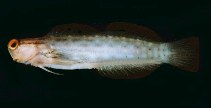| Family: |
Blenniidae (Combtooth blennies), subfamily: Salariinae |
| Max. size: |
5.8 cm TL (male/unsexed) |
| Environment: |
reef-associated; marine; depth range 1 - 20 m |
| Distribution: |
Western Pacific: known only from the Great Barrier Reef. More recently reported from the Chesterfield Islands (Ref. 11897). |
| Diagnosis: |
Dorsal spines (total): 12-13; Anal spines: 2-2; Anal soft rays: 15-17; Vertebrae: 31-33. Dorsal fin XII or XIII (rarely XIII), 13-15, deeply incised between spinous and segmented-ray areas. Anal fin II,15-17. Pectoral fin 12-14 (rarely 12 or 14). Segmented caudal-fin rays 13. Vertebrae 10 + 21-23. Dentary incisor teeth which includes anterior canines very similar in appearance from incisors, 46-54 in males and 48 to 56 in females, averaging more in females than males; posterior canines 0 or 1 (usually 1). Lateral line without vertical pairs of pores, extending posteriorly to point between vertical from interspace between 9th and 10th spines and vertical from base of 11th dorsal-fin spine (rarely anterior to base of 10th spine). With cirrus on posterior rim of anterior nostril; absent on anterior rim. Posterior portion of body with sparse peppering of fine, dark spots (Ref. 5296). |
| Biology: |
Adults feed mainly on a diet of coral polyps and mucous (Ref. 94105). Oviparous. Eggs are demersal and adhesive (Ref. 205), and are attached to the substrate via a filamentous, adhesive pad or pedestal (Ref. 94114). Larvae are planktonic, often found in shallow, coastal waters (Ref. 94114). |
| IUCN Red List Status: |
Least Concern (LC); Date assessed: 25 March 2009 Ref. (130435)
|
| Threat to humans: |
harmless |
Source and more info: www.fishbase.org. For personal, classroom, and other internal use only. Not for publication.
